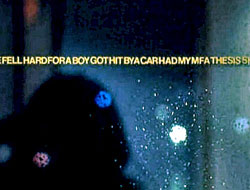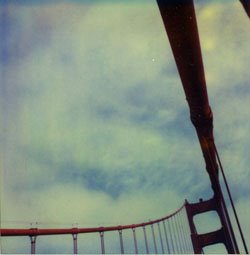Ho/Yun/Chaney revisit
 It’s not what you have; it’s how you use it.
It’s not what you have; it’s how you use it.
That might be a good way to begin a conversation about a trio of one-person shows – recently closed – at the Vox Populi Gallery on Cherry Street. Even though these three shows are technically unrelated and exist in separate spaces, there is a definite spirit that wafts between the sentiments of each. Experience, and how it is masked, revealed, uncovered and obscured is one common denominator – the experiences of both the artist and the viewer.
The most obvious use of obscuration is in Melissa Ho’s lovely grid of altered above-the-fold New York Times. On each of the text boxes she’s screen-printed blocks in analogous sky-blues. However, one might call it a subduing of the text, rather than obliteration; or perhaps appropriately enough, a “clouding,” rather than obfuscation, since some textual scraps can still be made out. It has been made avoidable, nonetheless, and we more easily focus on the color pictures, realizing some contrast between them and the calming effect of the blues. This subduing, in fact, makes the pictures pop. And through the grid, which suggests a sort of vague chronology, we can begin to ask about our experiences in a more pictorial, flashbacky sense – this past year; how has it affected us? Have we considered it objectively yet, or are we still choking on the leftover crumbs of past events? Ho’s new work is also a subdued version of her past uses of this technique – when I first saw her work, she was utilizing both multi-colored text blocking, and rectangles of floral photographs (see above image).
Rather than deliberately obscuring, Linda Yun makes use of some materials on her panel paintings - such as makeup and body glitter - which are normally used to create a mask, disguise, or focus attention. Simultaneously, she uncovers part of the gallery wall, slowly sanding off some of the – albeit benign – mask, in a taped-off rectangle, of changes through the space’s life. This delicate skin is captured in a dusty film on the floor. One’s senses, when standing in front of Yun’s works, experience an effect similar to approaching a made-up face – it is a deliberate but romantic deception. One only notices something is awry upon drawing closer. The infinite whites, lightly tinged with lilac and periwinkle edgings, suddenly become a tragically finite layer of snowy, glittering farce. And there is its wonder…we come to realize that beauty is neither skin-deep nor core. In its best sense it’s both (above image, a 2003 piece by Yun).

Experience and the related perception become more realistic and literal in Chaney’s work, but he uses no less subduing than the other two artists. Here it is more obviously an action – a multiple-choice quiz of what to include, and what to discard. And in that way, it makes sense that much of the work, if not photographs, is essentially photographic. Graceful shapes of telephone poles, parts of buildings and signs, and soaring power lines create compositions that are interactions of trapezoids, both within the particular pieces, and floating between the tiny dip- and triptychs of Polaroids. Silhouettes are the name of the subduing game in the drawings, and it accentuates their theatricality – the animated borders create empty stages, waiting for an austere, atmospheric kabuki, or an off-kilter karate movie. The color enters demurely. And in all their careful choices, they still carry the carefree possibilities of a hot California afternoon (above, Polaroid by Chaney).
(all images from the Vox Populi website, www.voxpopuligallery.org )





Tim, I read this a few days ago, and just reread it because of the link on the studio blog. Very insightful. You certainly have the makings of a great art writer!